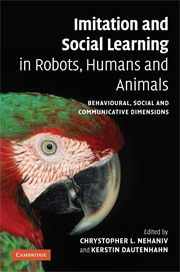 Imitation and Social Learning in Robots, Humans and Animals
Imitation and Social Learning in Robots, Humans and Animals Book contents
- Frontmatter
- Contents
- List of plates
- List of figures
- List of tables
- List of contributors
- Introduction: the constructive interdisciplinary viewpoint for understanding mechanisms and models of imitation and social learning
- Part I Correspondence problems and mechanisms
- 1 Imitation: thoughts about theories
- 2 Nine billion correspondence problems
- 3 Challenges and issues faced in building a framework for conducting research in learning from observation
- Part II Mirroring and ‘mind-reading’
- Part III What to imitate?
- Part IV Development and embodiment
- Part V Synchrony and turn-taking as communicative mechanisms
- Part VI Why imitate? – Motivations
- Part VII Social feedback
- Part VIII The ecological context
- Index
- Plate section
- References
3 - Challenges and issues faced in building a framework for conducting research in learning from observation
Published online by Cambridge University Press: 10 December 2009
- Frontmatter
- Contents
- List of plates
- List of figures
- List of tables
- List of contributors
- Introduction: the constructive interdisciplinary viewpoint for understanding mechanisms and models of imitation and social learning
- Part I Correspondence problems and mechanisms
- 1 Imitation: thoughts about theories
- 2 Nine billion correspondence problems
- 3 Challenges and issues faced in building a framework for conducting research in learning from observation
- Part II Mirroring and ‘mind-reading’
- Part III What to imitate?
- Part IV Development and embodiment
- Part V Synchrony and turn-taking as communicative mechanisms
- Part VI Why imitate? – Motivations
- Part VII Social feedback
- Part VIII The ecological context
- Index
- Plate section
- References
Summary
Introduction
We are exploring how primitives, small units of behavior, can speed up robot learning and enable robots to learn difficult dynamic tasks in reasonable amounts of time. In this chapter we describe work on learning from observation and learning from practice on air hockey and marble maze tasks. We discuss our research strategy, results, and open issues and challenges.
Primitives are units of behavior above the level of motor or muscle commands. There have been many proposals for such units of behavior in neuroscience, psychology, robotics, artificial intelligence and machine learning (Arkin, 1998; Schmidt, 1988; Schmidt, 1975; Russell and Norvig, 1995; Barto and Mahadevan, 2003). There is a great deal of evidence that biological systems have units of behavior above the level of activating individual motor neurons, and that the organization of the brain reflects those units of behavior (Loeb, 1989). We know that in human eye movement, for example, there are only a few types of movements including saccades, smooth pursuit, vestibular ocular reflex (VOR), optokinetic nystagmus (OKN) and vergence, that general eye movements are generated as sequences of these behavioral units, and that there are distinct brain regions dedicated to generating and controlling each type of eye movement (Carpenter, 1988). We know that there are discrete locomotion patterns, or gaits, for animals with legs (McMahon, 1984). Whether there are corresponding units of behavior for upper limb movement in humans and other primates is not yet clear.
- Type
- Chapter
- Information
- Imitation and Social Learning in Robots, Humans and AnimalsBehavioural, Social and Communicative Dimensions, pp. 47 - 66Publisher: Cambridge University PressPrint publication year: 2007
References
- 1
- Cited by


